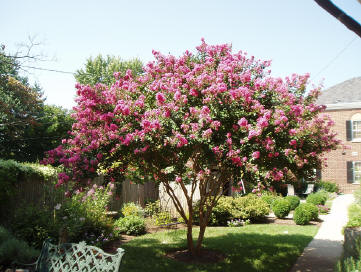Tony Murdock
Frederick County Master Gardener
 Crepe myrtles (Lagerstroemia indica) are one of the most beautiful and versatile plants one can have in the landscape. They are long flowering; with multi-colored exfoliating bark, and with proper pruning and placement you should enjoy their beauty for years. They are propagated as either single
stemmed specimens or multi-stemmed specimens. They can range in height from 5 feet to 33 feet. I seldom see insect or disease problems with the plants. Powdery mildew, black spot, sooty mold, tip blight, canker, root rot, aphids, Japanese beetle and ambrosia beetle can be problems.
Crepe myrtles (Lagerstroemia indica) are one of the most beautiful and versatile plants one can have in the landscape. They are long flowering; with multi-colored exfoliating bark, and with proper pruning and placement you should enjoy their beauty for years. They are propagated as either single
stemmed specimens or multi-stemmed specimens. They can range in height from 5 feet to 33 feet. I seldom see insect or disease problems with the plants. Powdery mildew, black spot, sooty mold, tip blight, canker, root rot, aphids, Japanese beetle and ambrosia beetle can be problems.
Pruning crepe myrtles is not a difficult task, as long as it is done at the proper time and with the proper tools. The ideal time to prune is late winter or early spring as the plant flowers on new growth. Pruning in December or November may cause the plant to start branching out before the winter
is done. Late cold spells could damage the new growth.
I prune crepe myrtles like a tree. I do not stub them back to a predetermined height, but instead I remove crossing interfering limbs, broken limbs. If I want to reduce the height I will remove long limbs back to a supporting limb that is ¼ inch diameter or larger to the one I am removing. Tip
pruning the ends of the limbs will also help in containing the size of the plant. I will remove suckers coming from the ground. Suckers can be removed at any time. Stubbing a 10-12 foot plant back to 6-8 feet will cause a profusion of weakly attached branches in the spring that are prone to breakage after flowering. The
best way to avoid stubbing is to buy a plant that will only grow to the height you want.
When I prune in the late winter, I will remove the old flower tips and the larger dead wood. I do not worry about all the small dead tips that are throughout the plant. Thinning out the interior of the plant allows more air and light to circulate. This should help in reducing certain diseases,
reduce the rubbing of branches, which may cause damage and facilitate flowering and leaf development.
I try not to remove more then 1/3 of the total leaf surface. Removing more then 1/3 of the foliage upsets the root to shoot ratio. The plant tries to re-establish this ratio by sending out lots of excess growth. It also uses up the energy stored in the roots and leaves the plant in a weakened state,
unable to fend off stressful situations.
The tools I use are a good pair of by-pass hand pruners, a pruning saw, loppers, extended reach pruners and if absolutely necessary a small chain saw. The chain saw is used to remove a large limb to the ground. It allows more room into the interior and if it is rubbing against other limbs causes
damage.
Placing the plant in the proper location is critical to its long-term health. When placing the plant in the landscape, you must consider its ultimate size and spread. You do not want to put it in a spot where it will grow into the house or other plants. Crepe myrtles are fairly fast growers that
should be placed in a wide open area that accents their grace and beauty.
They should be fertilized on a regular basis during the growing season. This helps with the flowering and leaf development. A soil test should be done to determine the best formulations of fertilizers to use. Take a sample from the planting area down to about six inches remove any turf, place in a
paper bag and send it off to a State University such as University of Delaware or Penn State. The University of Maryland no longer does soil testing. You can down load the forms by going to the University's web site.
Read other articles about tree care